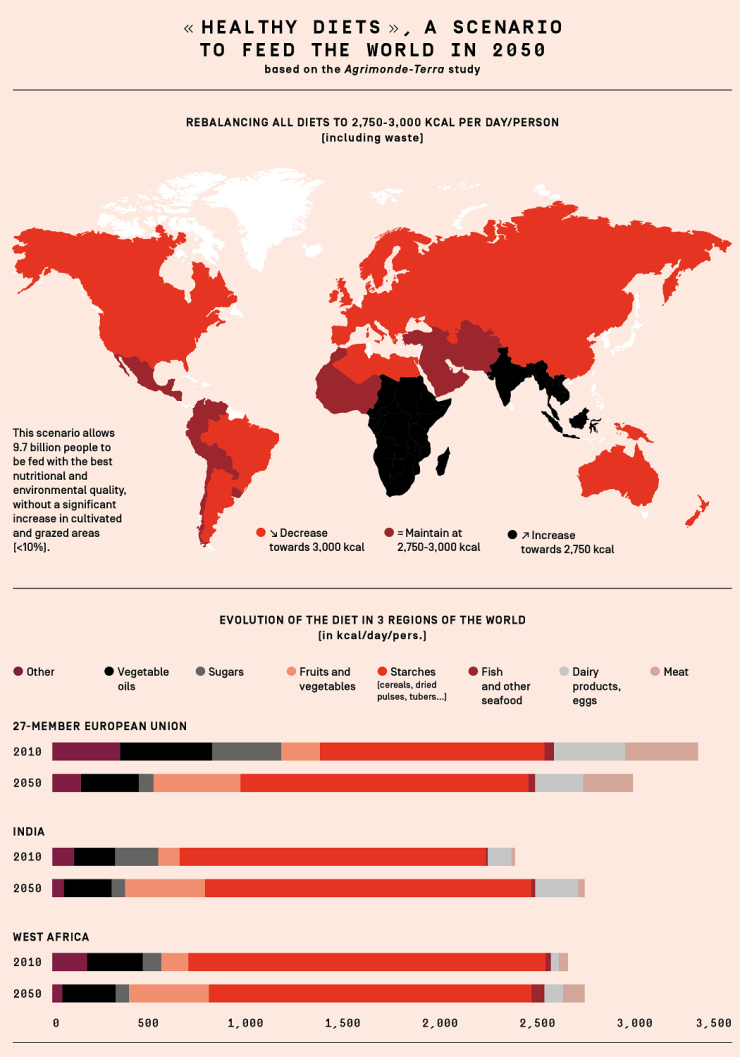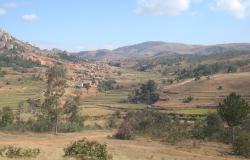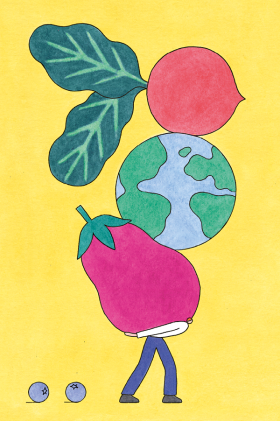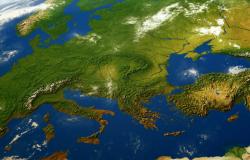Ressources dossier
Food, Global HealthHow to feed the planet in 2050?
Published on 18 January 2023
2 billion people have an unbalanced diet.
On 13 July 2020, the UN warned in its annual 1report that “since 2014, the number of hungry people worldwide has been slowly rising”, thus seeing the achievement of the second Sustainable Development Goal (SDG), “Zero Hunger”, move further away. In 2021, the same report highlighted the worsening of the trend by the COVID-192 pandemic, which increased the number of people suffering from hunger in the world (moderate or severe energy insufficiency) from 650 million in 2019 to 768 million in 2020. In addition to these populations facing problems of undernutrition, there are now also 2 billion people with an unbalanced diet, characterised by an excessive consumption of calories and certain nutrients (like salt, sugar and fats). This consumption encourages overweight and obesity, and increases the risk of various metabolic diseases (such as hypertension, diabetes and certain cancers).
Even though these figures may be frightening, given that demographic forecasts predict a population of 9.7 billion on the planet in 2050, research has been actively engaged for many years in order to gain knowledge in the face of a challenge that goes far beyond the mere question of the quantities to be produced, and to examine, alongside geopolitical strategies, agricultural and food systems as a whole. A challenge for which solutions must be developed over time and by mobilising numerous levers for action.
1. SOFI report produced annually by the UN and its agencies (FAO, WHO, WFP, Unicef, IFAD) – The State of Food Security and Nutrition in the World – 2020. url.inrae.fr/3yfS0PT.
2. The SOFI report estimated that between 80 and 130 million more people would suffer from hunger in 2020 as a result of the COVID-19 crisis.
The three pillars
In order to identify the paths to be explored, researchers are conducting foresight studies based on current data and trends. After considering the issue of food security exclusively from a production perspective in the early 2000s, advocating an increase in productivity without taking into account its impact on the environment or the quality and diversity of food, the studies quickly integrated the issues of losses and waste, as well as of the necessary changes to be implemented in food consumption. Gradually, the combination of agro-ecology, the reduction of losses and waste and the adoption of more balanced diets, combining more products of plant origin and fewer meat products (at least in developed countries), has emerged as a way of solving the food equation without leading to a damaging increase in the amount of land used.
Agrimonde-Terra: an integrated and systemic approach for 2050

The intertwining of issues highlights the need to think about the transition of food systems in an integrated manner, encompassing the role of land use and including environmental and health issues. With this in mind, CIRAD and INRAE presented in 2016 the results of a joint study on “land use and food security in 2050”. The aim of the Agrimonde-Terra foresight study was to identify the levers likely to improve food security and nutrition on a global scale by 2050. It is part of the research priority on global food security explored by the INRAE-CIRAD interdisciplinary research programme ‘GloFoodS’. Using both a quantitative and qualitative approach, based on current data and trends and combining possible evolutions of a wide range of factors (such as climate change, diets, urban-rural relations, agricultural structures, crop and animal production systems and public policies), the results have identified five possible scenarios.
In order to develop them, the Agrimonde-Terra foresight first analysed the long-term dynamics of food security, focusing on land use: access and agronomic potential, intensity and distribution between the different uses and services provided by the land. Secondly, quantitative hypotheses were formulated, taking into account the evolution of the global context in its technical, economic and social dimensions. These dimensions include climate change and its mitigation, demographic transitions and urbanisation, international trade, the evolution of diets, and technical progress in agriculture and livestock farming. To examine these hypotheses, simulations were carried out by integrating elements of the global context, in particular the climate projections of the Intergovernmental Panel on Climate Change (IPCC).

Following their first Agrimonde foresight study published in 2011 on ‘World food security in 2050’, INRA and CIRAD have turned their attention to the drivers of land use changes and their connections to world food security and climate. By 2050, the world’s land areas will have to feed an estimated population of 9.7 billion people while playing a supporting role to global forests in controlling climate change.
The different scenarios
Five scenarios were thus proposed: three based on current competing trends observed in most regions of the world (“Metropolisation”, “Regionalisation” and “Households”) and two corresponding to disruptive shifts in the relationship between land use and food security (“Healthy diets” and “Communities”). The Agrimonde-Terra foresight study concludes that most scenarios will not be able to ensure global food security in a sustainable way in 2050, due to an increase in deforestation for agricultural purposes, with some scenarios having ambivalent outcomes.
- “Metropolisation” would contribute most to the increase in the prevalence of overweight and obesity.
- The “Communities” scenario, based on the development of small communities and the management of common agricultural goods, would imply a reduction in food availability at global and regional level.
- In contrast, the “Regionalisation” scenario, with the networking of medium-sized cities and rural areas and the emergence of regional food systems based on family farming and traditional diets, would lead to ambiguous outcomes in terms of global food security.
- The “Household” scenario, in which family farms and cooperatives would be major actors in land use, would lead to a decrease in undernutrition but with ambivalent effects on overnutrition.
The positive prospects of the “Healthy diets” scenario
The scenario based on “healthy diets” would best reduce the prevalence of over- and under-nutrition and associated chronic diseases.
The “Healthy diets” scenario would best reduce the prevalence of over- and under-nutrition and associated chronic diseases. It proposes diets that combine a variety of products: fish, meat, milk, cereals, fruits, vegetables and legumes, with their micronutrients and fibre preserved. It implies a reconfiguration of agricultural and food systems through new alliances between stakeholders. The food chain becomes more efficient and reduces losses and waste. In this scenario, some regions would still be in a difficult situation, such as India and sub-Saharan Africa, due to their high population growth and low agricultural yields, with persistent risks of deforestation. However, with favourable global governance, this path would make it possible to have food that is compatible with the health of populations as well as with environmentally friendly agricultural practices and land use. The challenge will then be to prevent food crises, land grabbing, deforestation and mitigate the effects of climate change through concerted international action on food security and land use.
A systemic approach to ensure sustainability

In all cases, international trade will play a key role in ensuring global food security in 2050, and some regions, in particular North Africa and the Near and Middle East, are likely to remain highly dependent on food imports. Increasing the volume of food produced and its diversity in order to move towards a healthier diet in 2050 while limiting deforestation, will require a significant diversification of cropping and livestock systems.
The Agrimonde-Terra foresight confirms the importance of a systemic vision of the transitions necessary to ensure food and nutritional security for populations, using the levers of agricultural availability, diets and the optimisation of agricultural and food systems to reduce losses and waste.
As well as ensuring the food security of populations, the transition of food systems represents a powerful lever to promote human health and support environmental, economic and social sustainability. In order to succeed in this transition, transformations must take place in a profound manner over the next few years, through immediate actions and the implementation of progressive solutions and adaptive trajectories.
A challenge for all
Although there are now three main areas of research in the scientific communities on food security - changing production patterns based on the agro-ecological transition, reducing losses and waste, and changing food consumption patterns - the challenge is complex, with many issues that overlap and cut across sectors, territories and actors. The preceding pages give an idea of the actions that can be taken to change Western food behaviour.
Other work focusing more on the levers of agricultural production methods and the reduction of loss and waste is being developed in France and around the world (see GloFoodS programmes).
Policies need to encourage the diversification of farming systems and the development of agroecology to limit environmental impacts.
Public policies can play a central role by encouraging consumers to adopt diets that reduce the consumption of animal products when excessive, in favour of cereals, legumes, fruit and vegetables. This can be achieved by acting on access to and the cost of food, and by launching education and awareness-raising policies. They must encourage the diversification of farming systems and the development of agro-ecological practices that are useful for limiting the environmental impact of agriculture and livestock farming. They must also regulate access to agricultural land at the national level and the functioning of international trade in order to guarantee stable access to healthy food for all. The industry is called upon to develop economic models based on an offer that includes new, healthier and more accessible products. Everyone must commit to reducing losses and waste in food systems.
There is no single path mapped out, but rather a systemic transformation to be achieved with actions in each country and region consistent with each other and accountable in the face of global challenges. To study and design these transformations and contribute to the acceleration of transitions, INRAE develops its research with an integrative and interdisciplinary vision, and collaborates with public and private actors to facilitate the transfer of knowledge for innovations and public policies likely to build sustainable food systems, specific to each region, beneficial to both humankind and the Earth.
The transformation of our food systems requires close coordination between stakeholders’ strategies and between countries. Research is there to accompany them and foster this coordination.
Agricultural land: the projections for 2050
Conducted by INRAE (Directorate for Expertise, Foresight and Advanced Studies), the study “European Agriculture in 2050” proposes projections for 2050 of the various components of the world’s agricultural and food system, dividing it into 21 regions, 8 of which are in Europe.
The need for cultivated land
If current diets are maintained in developed regions and the nutritional transition continues in emerging or developing regions, the need for cultivated land in the world would vary from +223 to –11 million hectares, in addition to the 1.5 billion hectares cultivated in 2010. It would be considerable in sub-Saharan Africa and India. A hypothesis of disruption towards “healthy” diets (as defined by the WHO) would ease the pressure somewhat, but not as much as might be expected: the need would change on a global scale from +194 to –51 million hectares compared to 2010.
In Europe, as in other developed regions, such a change would lead to a reduction in total caloric intake and consumption of animal products, allowing for a decrease in cultivated areas ranging from –14 to –30 million hectares.
Potential surpluses in Europe
The “surplus land” that could appear in several regions of Europe, particularly in Central and Eastern Europe, would be too small for its agricultural use to contribute to food security in other regions of the world.
It could, however, be an opportunity to reduce our dependence on soybean imports by developing oilseed crops, or to move towards less input-intensive cropping systems that require more land. Depending on the yield and diet hypotheses selected, between 4 and 44 million tonnes of soybean meal could thus be produced on this “surplus land”, making it possible, in the best-case scenario, to avoid imports altogether, while still leaving 9 million hectares “available” for other uses or for yield reductions.
The results of this study, carried out for the Pluriagri association1, and in particular the uncertainties that it integrates or points out, are available to stakeholders in order to help them develop the (re)orientation of their policies, including in the context of the European Green Deal, which aims at a transition towards a more sustainable agriculture.
1. Pluriagri is an association that brings together various field crop stakeholders: Avril, Confédération générale des planteurs de betterave, Unigrains and Crédit Agricole SA.
Methodology
The study takes into account the combination of the effects of climate change (according to the IPCC’s RCP-6.0 scenario) and technical developments (based in particular on the FAO’s 2012 and 2018 projections) on agricultural yields. It also incorporates possible changes in the diets of a rapidly growing world population by 2050.
The proposed simulations are based on a set of contrasting hypotheses aimed at integrating the uncertainties that weigh on the evolution of these variables and determine, on this basis, the areas under cultivation by 2050 in each region of the world, the levels of production and the use of or contribution to international trade of each region.

The “European Agriculture in 2050” study, conducted by INRAE at the request of the Pluriagri* association, follows on from the foresight work on changes in world food security previously undertaken by INRA and CIRAD, the Food and Agriculture Organization of the United Nations (FAO), the International Food Policy Research Institute (IFPRI) and the International Institute for Applied Systems Analysis (IIASA). The study’s insights, which reflect the impacts of climate change on agricultural production, will help inform European and international public policies.
-
Élodie Regnier / Anaïs Bozino
(Send email)
Author / translated by Alessandra Riva
Communications Department
